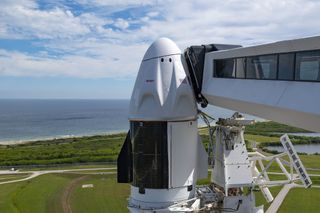SpaceX's next astronaut launch for NASA delayed again by bad weather (and a possible Dragon landing)
Crew-3 will now launch no earlier than Monday (Nov. 8).

CAPE CANAVERAL, Fla. — SpaceX's next astronaut launch for NASA has been delayed again.
The U.S. space agency and SpaceX have pushed the launch of the Crew-3 mission, which will send four astronauts to the International Space Station, from Saturday (Nov. 6) to Monday (Nov. 8) at the earliest, because of anticipated bad weather over the coming days.
NASA and SpaceX are also now considering whether to bring the four astronauts of the previous mission, Crew-2, back down to Earth before sending Crew-3 skyward.
Live updates: SpaceX's Crew-3 astronaut mission
A SpaceX Crew Dragon capsule and Falcon 9 rocket were originally scheduled to launch Crew-3 early Sunday morning (Oct. 31) from Pad 39A at NASA's Kennedy Space Center here in Florida. But before the crew could climb aboard, NASA announced a 72-hour delay, citing poor weather conditions along the rocket's flight path.
Then, a minor medical issue cropped up with one of the astronauts, forcing the agency to push the launch out to no earlier than 11:36 p.m. EDT on Saturday (Nov. 6; 0336 GMT on Nov. 7). However, Mother Nature has now nixed that plan, as the weather conditions all weekend look pretty poor, according to forecasters at the 45th Space Delta here at Cape Canaveral.
So NASA and SpaceX are rethinking their plans for both launch and splashdown.
Get the Space.com Newsletter
Breaking space news, the latest updates on rocket launches, skywatching events and more!
"Mission teams are now considering whether to return the agency's SpaceX Crew-2 mission from the space station ahead of launching the next crew rotation due to the associated weather conditions for both launch and recovery operations," agency representatives wrote in a blog post on Thursday (Nov. 4).
The Crew-2 astronauts currently on station — NASA's Shane Kimbrough and Megan McArthur, along with European Space Agency (ESA) astronaut Thomas Pesquet and Japanese Aerospace Exploration Agency spaceflyer Akihiko Hoshide — were originally slated to come home on Thursday, assuming the Crew-3 quartet of NASA's Raja Chari, Tom Marshburn, Kayla Barron and ESA's Matthias Maurer launched on Oct. 31.
The original Crew-3 delay to Wednesday (Nov. 3) put Crew-2's earliest departure on Nov. 7. However, the weather is the most important factor in determining when each mission either gets off the ground or splashes down.
Crew-2, which launched in April, is in a bit of a time crunch, since its Dragon spacecraft is rated to stay in space for approximately 210 days, or 7 months. With that deadline fast approaching, and the weather looking bleak, NASA may decide to bring that mission home first.
"These are dynamic and complex decisions that change day by day," Steve Stich, NASA's Commercial Crew program manager said in the blog post. "The weather in November can be especially challenging, so our goal is to move forward on the plan with the highest probability of mission assurance and safety."
The earliest Crew-2 could come home is now Sunday (Nov. 7), while the earliest that Crew-3 could launch is Monday night (Nov. 8). NASA says it will continue to monitor weather conditions both at the Cape and downrange to determine the best course of action in the next few days.
The Crew-3 astronaut's medical issue is expected to clear up by launch day, NASA officials said.
Follow Amy Thompson on Twitter @astrogingersnap. Follow us on Twitter @Spacedotcom or Facebook.
Join our Space Forums to keep talking space on the latest missions, night sky and more! And if you have a news tip, correction or comment, let us know at: community@space.com.

Amy Thompson is a Florida-based space and science journalist, who joined Space.com as a contributing writer in 2015. She's passionate about all things space and is a huge science and science-fiction geek. Star Wars is her favorite fandom, with that sassy little droid, R2D2 being her favorite. She studied science at the University of Florida, earning a degree in microbiology. Her work has also been published in Newsweek, VICE, Smithsonian, and many more. Now she chases rockets, writing about launches, commercial space, space station science, and everything in between.
